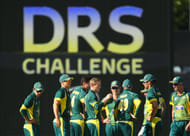Decision Review System (DRS) has been amidst controversy since its inception. What was designed to be an improvement in the game has turned out to be an unnecessary complication, creating some divide between the cricket fraternity.
Implemented to reduce howlers
DRS was introduced with the objective of reducing number of howlers meted out by umpires. It was born out of the womb of technology to erase the faults of human judgement. As time went by, DRS has been the cause of distress on more occasions than an agent to allay it. It has made a beautiful sport into a needless muddle of technology and numbers.
DRS may have its own advantages like the fact that it can potentially help in improving the accuracy of decisions. With a bit of mathematics, we can show that
P(c) = P(u) + P(u') * P(r) = 0.8 + (0.2*0.9) = 0.98, where
P(c) = probability of a correct decision given by umpire using DRS
P(u) = probability that umpire makes a correct decision (in this case assumed as 0.8)
P(u') = probability that umpire makes a wrong decision (in this case 0.2)
P(r) = accuracy of the DRS technology
Muddle! Isn't it?
But it is the process of achieving this 98% accuracy which is a cause of bother.
DRS is still not 100% accurate
The basic and major flaw in DRS is that the technology is not foolproof. It means that even after the use of technology available there is no guarantee that the decision given will be accurate, failing to fulfill the promise of its inception. A recent incident involving Pakistan's Shan Masood should serve as an example.
Even if we overlook this fact and carry on with the technology which is accurate around 90% of the time, the second drawback is that it is inconsistent. The output depends largely on factors such as positioning of the cameras, the quality of cameras, the number of cameras used and several others. Hence, there may be a case when two different decisions are given based on the factors mentioned above, which again is not much to cheer about.
Apart from these two major areas of concern, there are other issues which make DRS unfeasible in its current form.
DRS involves technicalities which are best left to the engineers and software developers sitting in the offices of these technology providers. Consider the following criteria for the decisions to be overruled or sustained while appealed through DRS:
1. If the impact of the ball is more than 2.5m away from stumps, the ball must have traveled at least 40cm before making a contact with the batsman's pads to overrule the on-field umpire's call.
2. If the impact of the ball is more than 3.5m away from the stumps, then the decision of not-out will stand.
And if this is not ridiculous enough the "clipping the bells", "more/less than half of ball hitting the stumps" debate is sure to have one at the end of his tether. We are splitting hair here.
We are trying to acquire precision within millimeters when no such thing is required. Time wastage is another thing which has resulted from this obsession for 100% accuracy. Every referral takes on an average 2-3 minutes of time which is irksome to the spectators and may cause lapse in concentration for the batsmen.
Teams use DRS as a tactic
For those who are staunch supporters of DRS in its present form, here are a few more arguments to support as to why the DRS is not suited to the game of cricket at this moment. DRS undermines the authority of the umpire with the players given an opportunity to question the umpire's judgement at every possible instance. What is more saddening is the fact that certain teams use DRS as a tactic against the opposition and the umpire.
Far too often, we hear vociferous appeals from the fielding side but when it comes to using the review, they shy away. A logical question arises then, why was the side so confident when appealing? When it is given a choice to review the decision, it decides to keep the reviews safely in the bank. Isn't this then a tactic to pressurize the umpires? What if an umpire succumbs to this pressure and the batting team does not have any reviews left to redeem itself?
Such and many other tactical ploys are hatched when the focus should be on strategies concerning skills of the players. DRS, thus, has become a tactical pawn in hands of captains. Joel Garner was not far away from the truth when he labelled "DRS" as a gimmick.
DRS can be a useful ally in the future when it is dependable and far less esoteric. If possible, let us test DRS in domestic competitions and if the results are inspiring let DRS become an integral part of the game at the highest level. But for the moment let us concentrate more on improving the standards of umpires if that is what our problem is. And also we must learn to take things in out stride, because there are days when things work for us and other days when we are at the receiving end. In the end, everything it averages out over a period of time.
Let us keep this game human, for it is only humans who can perceive its beauty.
Looking for fast live cricket scores? Download CricRocket and get fast score updates, top-notch commentary in-depth match stats & much more! 🚀☄️
